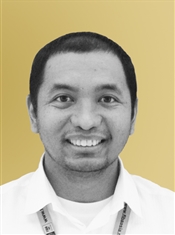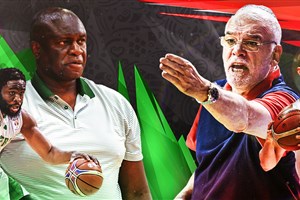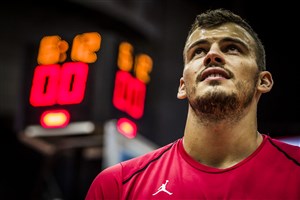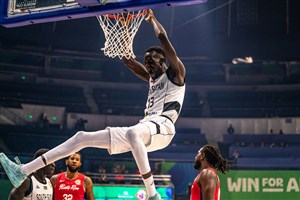
Hachimura and Watanabe - Japan's future on the loose in the present
MANILA (Enzo Flojo's Asia on My Mind) - Rui Hachimura and Yuta Watanabe may be the cornerstones for Japanese basketball's future, but they aren't wasting any time making waves in the present.
Hachimura and Watanabe - products of Japanese basketball's robust youth development program - were stellar for the Akatsuki Five in the opening window of the FIBA Basketball World Cup 2019 Asian Qualifiers second round this month.
In Japan's two wins over Kazakhstan and Iran, the 6ft 9in (2.06m) Watanabe averaged 17.5 points, 3.0 rebounds, 1.5 steals and 1.5 blocks per game, giving Japan a marvelous presence at the wings who can significantly affect the game from both ends of the floor.
As for Hachimura, the 6ft 8in (2.03m) forward has starred in four contests for Japan, putting up a dominant stat-line - 21.5 points, 6.0 rebounds, 1.8 steals and 1.0 block per game while shooting 58% from the field. He has scored 24 or more points in three of those four games, underscoring his effectiveness as the team's frontline anchor.
Japan have actually rattled off four wins in a row in the Asian Qualifiers, making them the hottest team right now in Group F. They are currently sporting 4 wins against 4 defeats, leapfrogging past both Qatar and Kazakhstan and knocking on the door of the top three right behind the Philippines, who have 5 wins in 8 games.
View this post on Instagram#AkatsukiFive #FIBAWC #THISISMYHOUSE 🇯🇵70-56🇮🇷 #日本一丸 🇯🇵 熱いご声援ありがとうございました‼️ #🏀
To say that Hachimura and Watanabe have been potent is an understatement. They have, in fact, been difference-makers for the Japanese. One may even surmise that had both played since the beginning of the Asian Qualifiers, perhaps Japan would be much higher in the Group F table. They give the squad so much size, length, talent and versatility.
Both Hachimura and Watanabe can play any of the frontline positions - even center - and their skill-sets allow them to play from the perimeter, too. This gives head coach Julio Lamas a lot of flexibility in terms of lineup composition, and takes a lot of pressure off from veterans like Yuki Togashi, Makoto Hiejima and Joji Takeuchi to carry the load.
More than their impact on the hardwood, however, the collective presence of Hachimura and Watanabe has done wonders not just for the national team but for basketball as a whole in Japan. This is mainly because of how they've proven that a successful transition from Asian hoops to the US NCAA and in Watanabe's case, perhaps to the NBA this coming 2018-2019 season, is attainable.
Watanabe, who was born and raised in Kagawa - the smallest prefecture in Japan - started playing basketball when he was just 6 years old, learning from his parents and sister. His mother, Kumi Kubota, played professionally for the Chanson V-Magic and the national team, while his father, Hideyuki Watanabe, also once saw action for the now defunct Kumagai Gumi Bruins. Yuta's older sistser, Yuki Watanabe, also played for the Aisin AW Wings in the WJBL. Truly, basketball is in Yuta's blood, and now he has the opportunity to be the second native Japanese to make it to the NBA after his namesake Yuta Tabuse did it many years ago. He is expected to split time between the Memphis Grizzlies and their NBA G League affiliate, the Memphis Hustle this season.
Memphis, population 650,000, sure is a long way from Watanabe's hometown of Miki, Kagawa, population 28,000, but if things fall into place, the 23-year-old is set to blaze a trail anew for Japanese hoops.
And the guy who will most likely follow him on that trail is 20-year-old Hachimura, who is projected to be among the breakout stars not just for the Gonzaga Bulldogs but for the entire US NCAA this coming 2018-2019 season. It shouldn't really be a surprise, though, given how Hachimura was the leading scorer of Japan's U16 and U18 teams back in his time and has dramatically increased his production from his freshman year at Gonzaga (2.6 points and 1.4 rebounds per game) to his sophomore year in 2017-2018 (11.6 points, 4.7 rebounds per game).
Hachimura was actually heavily recruited coming out of high school in Japan as other schools like LSU, St. John's and Vanderbilt joined Gonzaga in trying to land the Japanese phenom's talents. In the end, Hachimura chose Gonzaga because it reminded him of his hometown of Toyama and because of his desire to balance his studies with his athletics.
That will be much more challenging to accomplish now with Japan vying for World Cup qualification and with two more Asian Qualifiers windows on top of the fact that Hachimura will play a bigger role for Zags. The media attention will also be much more intense, and though Hachimura has admitted he's not very comfortable being in the spotlight, at least it's one way his family back home in Toyama can follow his basketball journey.
He hopes, just like Watanabe, that this journey will lead to the NBA and more basketball success for the Japanese national team in the future.
The future - both Hachimura and Watanabe are primed for it - but it seems they cannot wait because they are already making such a significant impact on Japanese basketball right now.
This Watanabe-Hachimura combo is 💪💪💪 https://t.co/uBOalJqKS6 #FIBAWC Qualifiers
— Enzo Flojo (@hoopnut) September 19, 2018
Enzo Flojo
FIBA
FIBA's columnists write on a wide range of topics relating to basketball that are of interest to them. The opinions they express are their own and in no way reflect those of FIBA.
FIBA takes no responsibility and gives no guarantees, warranties or representations, implied or otherwise, for the content or accuracy of the content and opinion expressed in the above article.


















